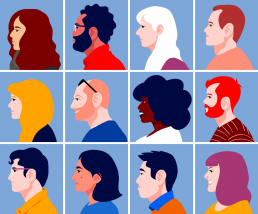Diversity Matters
Shanice Natalia

Written by Shanice Natalia
Shanice is a Part 1 Architectural Assistant, interested in writing about the mental health and well-being of young adults; championing inclusivity and community connections through food and architectural heritage; identity and immigration, specifically focusing on diaspora and establishing ‘Home’.
Could architects be doing more to address and provide solutions to the world’s current social, cultural and environmental issues?
As an industry, we generally try to be proactive and keep ourselves well informed and there is fundamental change happening within construction, along with a growing awareness in the wider society in relation to diversity and other commonly understood issues.
Diversity is often interchangeably used with ‘Inclusivity’, demonstrating the need for Intersectionality: whereby a range of demographics is acknowledged and recognised as having interdependent discriminative experiences, as defined by TOCA Architects.
Contrary to popular characterisation, diversity isn’t simply about race and forming a corporate level of cultural intelligence – it can be measured across the variables of age; sexual orientation; disability; gender; geography and ethnic background.
As society evolves and becomes more culturally aware, architectural practices are already keen in following suit, to present methods that mitigate biases within both the workplace and our projects – thinking beyond the ‘typical’ users of buildings and spaces.
Yet over the years, designing inclusively has not always been at the forefront of the design process which ultimately limited and, in some instances, continues to limit our ability to design effectively for all.
Within the architectural industry, diversity should not be a ‘nice to have’ but a moral obligation, and meeting more than the basic human needs of our communities.
The Architects Registration Board (ARB)’s 2020 survey corroborates the lack of representation of minority ethnic groups and women: 80% of architects classed their ethnicity as ‘white’ and only 29% of registered architects were women. Promoting inclusivity within the workplace is vital, as buildings are the products of today’s architects’ individuality. Thus, it is imperative that the industry successfully reflects the community for which it is ultimately designing.

New buildings should enhance the identity and inclusivity of neighbourhoods and should be able to adapt to everchanging community requirements; whereby public realm strategies strengthen community connections and promote our wellbeing. This is psychologically invaluable in bringing various aspects of the community together, whilst creating a legacy for future generations, who would be encouraged to improve their local environments.
Documents such as the National Space Standards and The London Plan, both updated annually, demonstrate the importance of inclusive and accessible affordable housing, whereby London’s growth and development is shaped by daily decisions made by planners; planning applicants, decision-makers; and Londoners across the city.
Organisations with a specific remit, such as ‘Future of London’ have discovered and advocated ways to design diversely, by starting at a smaller scale to focus on creating impactful design decisions to benefit the user. By designing for all, spaces and their users become more diversified and inclusive in their nature – thus emphasising that the architectural industry should be intrinsically diverse itself. Spaces are subconsciously assessed by their users, through the evaluation of how practical they are and whether it conforms to an inclusive environment, as opposed to imposing barriers of any kind.
One area where catering to the needs of a minority is most apparent, includes the work of the Royal National Institute of Blind People, who ensure that our streets are well planned for sight-impaired people to move around safely and comfortably, including the ways in which outdoor restaurants/cafés are situated on public pavements. Interestingly, by respecting these constraints, we are all able to benefit from tidier and better defined spaces, as there is an increased level of order.
Continuing with placemaking we also have the emergence of Innovation Districts nationwide, which seek to achieve long-term benefits and an overall positive contribution particularly to economically and socially deprived cities. Innovation Districts involve the combination of invention and enterprise to provide value-added growth through increased connectivity, stitching areas back into their surroundings and granting them a purpose beyond the ‘innovation’ community, as integral parts of the wider city. This is further demonstrated by ‘BeFirst’ who currently work to accelerate regeneration and promote diversity in the London Borough of Barking and Dagenham, through the parallel objectives of developing new homes and new jobs by 2037.
Diversity matters within public spaces and to produce safe and solution-oriented environments for users, involving a collaboration of several stakeholders to ensure the space has been effectively designed.
Everyone uses spaces differently and will have their own personal needs around buildings and public spaces. The feminist architectural practice ‘Equal Saree Architects’ in Spain have effectively developed ways in which cities can prioritise women’s needs in public places. Some factors considered include: the spatial arrangement of public toilets; reducing the domination of cars in Barcelona to provide more street space for pedestrians and cyclists to use the parks, benches, and playgrounds; alongside providing additional seating systems, as women tend to seek these for both mobility purposes and social interactions.
When designing public spaces, the following questions should be asked: What routes are taken to get from one place to another? Are there dark roads lined without natural surveyance – creating potential blind spots? Are there sites where large intimidating groups of people usually congregate? 71% of women in the UK have experienced sexual harassment in a public space (UN Women YouGov Survey and ONS 2021).
Extensive site mapping has revealed that girls and young women tend to be excluded from the design consideration of parks and public spaces. The organisation ‘Make Space for Girls’ has campaigned to specifically design spaces for girls and young women aged 16-24 in the UK.
Imogen Clark of ‘Make Space for Girls’ confirmed that spaces with water; nature; clear sightlines; sufficient lighting; and no dead-end footpaths, were classified as creating a ‘safe space’ for schoolgirls. Around London, Stratford’s Queen Elizabeth Olympic Park for instance, where there are many linear walkways, creates feelings of intimidation for young women by reason of groups of men reported to be gathering on this route.
A lack of consideration for female safety in public spaces creates feelings of isolation, fear, intimidation, and harassment. This is a consequence of poor lighting; a lack of non-linear footpath routes; which are typically found on highlines, canals and construction sites. BBC journalist, Stephanie Hegarty rightly stresses that “cities are supposed to be built for all of us, but they aren’t built by all of us.”
Critical principles that we should all be adhering to, to ensure that we practise diversely and produce inclusive designs within our projects:
- Acknowledging the true meaning of diversity, and the clear differences that our employees possess
- Offering choices where a single design solution cannot accommodate all
- Providing for flexible use, to anticipate future users’ changes in both the workplace and design projects
- Creating buildings and environments that are safe and enjoyable for all to use
It may be true to say that architects have not always designed as appropriately as they might have done, for a multitude of reasons or a possible lack of awareness that these issues even require solutions. However, at an early stage in my architectural career, I am fortunate to have found myself at BoonBrown who are conscious of these matters and take a proactive stance both within the workplace and on projects. I would hope and expect that other practices are equally cognisant of such considerations. It is important that we do not rest on our laurels and that we maintain consistent awareness of those around us in our ever-changing communities. We as architects, as those who influence and shape our society through buildings and spaces, have an obligation to respond to these constraints and recognise them as opportunities in our creativity, to design spaces that are beneficial for all.
